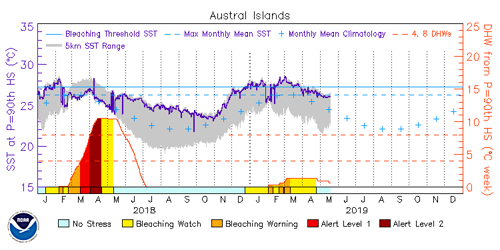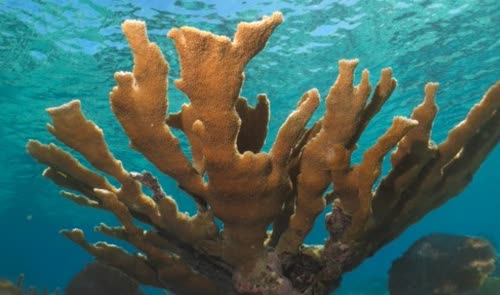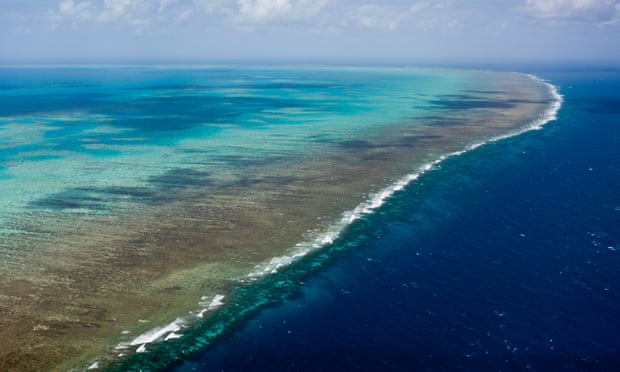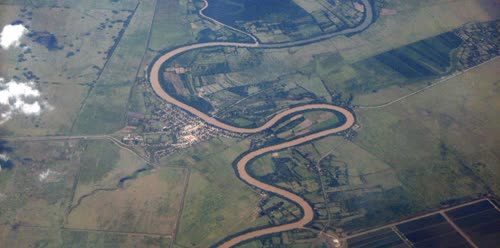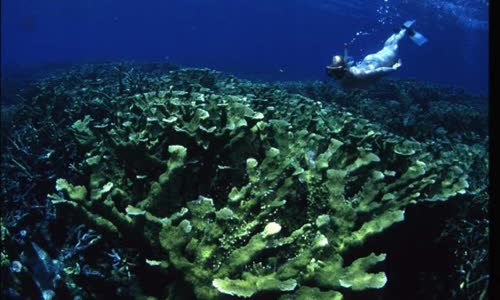|
Total reef losses due to climate change are unlikely There are winners and losers among corals under the accumulating impacts of climate change, according to a new scientific study. In the world’s first large-scale investigation of how climate affects the composition of coral reefs, an international team of marine scientists concludes that the picture is far more complicated than previously thought - but that total reef losses due to climate change are unlikely. Ref: http://www.cell.com/current-biology/abstract/S0960-9822%2812%2900255-2 |
|
For cold water corals, warming is beating acidification to drive a growth spurt ...The scientists found that the calcification rate of the corals did depend on the location, but not in the direction that the ocean acidification hypothesis would predict. The two southernmost populations showed definite increases in calcification since 1900, up to a 23.7 percent increase in one location. Among the more northern populations, four showed no change in calcification over time, and two showed decreases in calcification rates. If ocean acidification were driving these trends, the southernmost waters would be more prone to lowered pH in that region, and corals there would show decreased calcification. Instead, the calcification rates have more to do with temperature than acidification. The scientists compared changes in the sea surface temperature at each location to the changes in calcification rates. Coral populations where the sea had warmed the most (those living in the coldest water) actually had the largest increases in calcification rates, and populations with smaller increases in sea surface temperature (where the sea was warmer to begin with) either had no change in calcification or underwent declines. The results show that temperature may have a larger impact on coral growth than acidification does, at least in this set of samples. Rather than be adversely affected by warming oceans, coral reefs in cold water take advantage of higher temperatures that bring them closer to optimal growth conditions. However, temperature increases in other locations may put the water over the ideal temperature for coral growth. This may either cause declines in calcification directly, or leave them susceptible to acidification. Due to the diversity of coral species and the large geographic range in which they live, corals aren’t responding uniformly to climate change. Furthermore, the effects are likely to change over time; even though some populations are benefitting initially from changes in temperature, these advantages will likely disappear as the warming process continues... |
|
Why does coral bleaching happen even when it gets colder? And why is it, when it's even warmer than when coral did bleach, was there no bleaching at all?
|
|
All over the world, coral reefs are dying at an alarming rate. But off Cuba, they are flourishing. Coral Reefs in the Caribbean have been hit particularly hard. Since 1970, about half of the coral cover in the region has disappeared, including almost 95 percent of the spectacular elkhorn coral. “After the Soviets pulled out [in 1991], Cuba couldn't afford fertilizers and pesticides, so they were essentially forced into organic farming — and that's had a beneficial effect on corals,” Guggenheim explains. The result has been far less nutrient pollution in the ocean waters surrounding Cuba. Nutrients in the water do the same thing in the ocean that they do on land: They fuel the growth of plants and algae — and in the ocean those algae overgrow and ultimately kill coral reefs. |
|
Cuba’s rivers run clean after decades of sustainable farming The island’s waterways have lower levels of fertilizer-linked pollution than the Mississippi River in the United States. |
|
The disease pathogen Vibrio is the actual cause of coral bleaching Pollutant in seawater near man, mostly fungicides, disable the corals immune system leaving them prone to fatal Vibrio infection, which would not hurt them otherwise. |
|
Does ocean acidification alter fish behavior? Fraud allegations create a sea of doubt.
As one journalist covering the research put it, “Ocean acidification can mess with a fish’s mind.” The findings, included in a 2014 report from the Intergovernmental Panel on Climate Change (IPCC), could ultimately have “profound consequences for marine diversity” and fisheries, Munday and Dixson warned.
|
|
Great barrier reef The plan to remediate it cleans up water pollution spilling into the sea, mostly agricultural runoff. No mention of temperature. |
|
Stanford researchers show corals can turn certain genes on and off to cope with heat Some corals adjusting to rising ocean temperatures, Stanford researchers say Research led by Stanford scientist Steve Palumbi reveals how some corals can quickly switch on or off certain genes in order to survive in warmer-than-average tidal waters. |
|
The site also offers a fascinating setting to study corals and marine life that are making a home among high levels of CO “These high CO2 environments that are actually close to thriving reefs, how does it work?” said Cardenas, who is a professor in the Jackson School of Geosciences at UT Austin. “Life is still thriving there, but perhaps not the kind that we are used to. They need to be studied.”
|
|
Regional coral responses to climate disturbances and warming is predicted by multivariate stress model and not temperature threshold metrics Oceanic environmental variables derived from satellites are increasingly being used to predict ecosystem states and climate impacts. Despite the concerted efforts to develop metrics and the urgency to inform policy, management plans, and actions, few metrics have been empirically tested with field data for testing their predictive ability, refinement, and eventual implementation as predictive tools. In this study, the abilities of three variations of a thermal threshold index and a multivariate stress model (MSM) were used to predict coral cover and community susceptibility to bleaching based on a compilation of field data from Indian Ocean reefs across the strong thermal anomaly of 1998. Field data included the relative abundance of coral taxa 10 years before the large-scale temperature anomaly, 2 years after (1999–2000), and during the post-bleaching recovery period (2001–2005) were tested against 1) a multivariate model based on 11 environmental variables used to predict stress or environmental exposure (MSM), 2) estimates of the time until the current mean maximum temperature becomes the mean summer condition (TtT), 3) the Cumulative Thermal Stress (CTS) for the full satellite record, and 4) the 1998 Annual Thermal Stress (1998 ATS). The MSM showed significant fit with the post-1998 cover and susceptibility of the coral community taxa (r2 = 0.50 and 0.31, respectively). Temperature threshold indices were highly variable and had relatively weak or no significant relationships with coral cover and susceptibility. The ecosystem response of coral reefs to climatic and other disturbances is more complex than predicted by models based largely on temperature anomalies and thresholds only. This implies heterogeneous environmental causes and responses to climate disturbances and warming and predictive models should consider a more comprehensive multiple parameter approach. |
|
Great Barrier Reef: scientists find high levels of pesticides and blast chemical regulator Pesticides found in reef catchment include Atrazine, a herbicide banned in 60 countries |
|
The resilience of coral reefs Dr. Bruce Carlson produced a wonderful video demonstrating the resilient capacity of coral reefs if humans would simply stopped interfering with nature. It seems like common sense, but it's a lesson many people and governments have not taken to heart. |
|
With each location they found that the seawater became increasingly more acidic as they moved toward land. "When we first plotted those data, we were shocked," said chemical oceanographer Kathryn Shamberger of the Woods Hole Oceanographic Institution (WHOI). Marine scientists working on the coral reefs of Palau have made two unexpected discoveries that could provide insight into corals' resistance and resilience to ocean acidification.
|
|
Cuban rivers free from pollution thanks to green farming CUBA’s rivers are running clean, with low levels of fertiliser pollution, thanks to decades of sustainable farming, according to a joint scientific study published in the journal Nature on Tuesday.
|
|
A study published in the international journal Marine Biology, reveals what's really killing coral reefs. July 15, 2019;
|
|
Coral makes its on sunscreen Coral makes a chemical that naturally blocks UV rays. If the sun was becoming more intense this would counteract it. However, if pollution disturbed a critical biochemical pathway the coral needs to make this sunscreen, then it would not be able to do so and could in fact exhibit heat stress at normal levels of solar exposure.
|
|
Threatened Caribbean Coral Is Able to Mitigate the Adverse Effects of Ocean Acidification on Calcification by Increasing Feeding Rate Global climate change threatens coral growth and reef ecosystem health via ocean warming and ocean acidification (OA). Whereas the negative impacts of these stressors are increasingly well-documented, studies identifying pathways to resilience are still poorly understood. Heterotrophy has been shown to help corals experiencing decreases in growth due to either thermal or OA stress; however, the mechanism by which it mitigates these decreases remains unclear. This study tested the ability of coral heterotrophy to mitigate reductions in growth due to climate change stress in the critically endangered Caribbean coral Acropora cervicornis via changes in feeding rate and lipid content. Corals were either fed or unfed and exposed to elevated temperature (30°C), enriched pCO2 (800 ppm), or both (30°C/800 ppm) as compared to a control (26°C/390 ppm) for 8 weeks. Feeding rate and lipid content both increased in corals experiencing OA vs. present-day conditions, and were significantly correlated. Fed corals were able to maintain ambient growth rates at both elevated temperature and elevated CO2, while unfed corals experienced significant decreases in growth with respect to fed conspecifics. Our results show for the first time that a threatened coral species can buffer OA-reduced calcification by increasing feeding rates and lipid content. |
